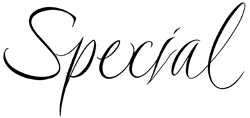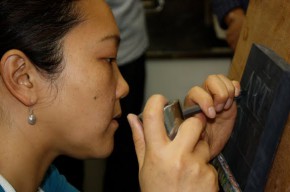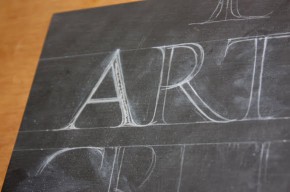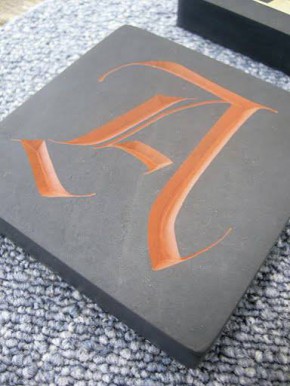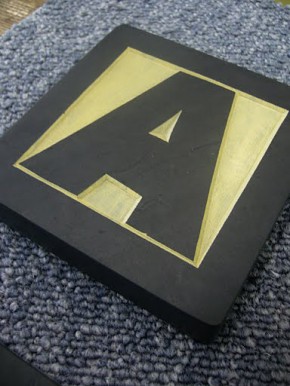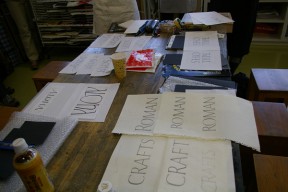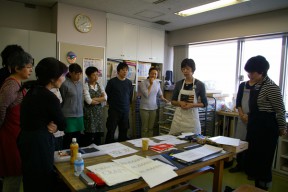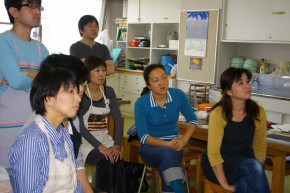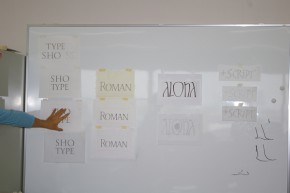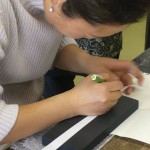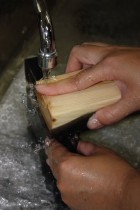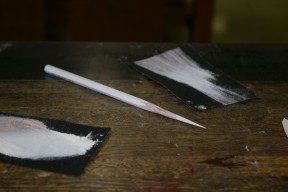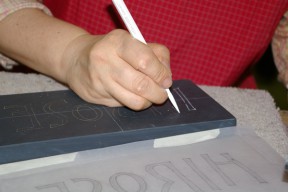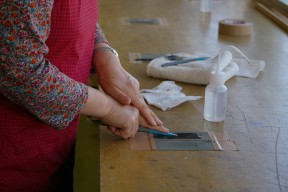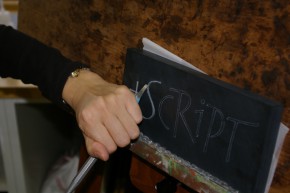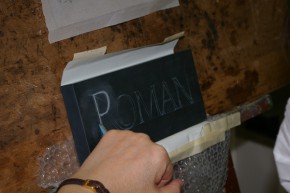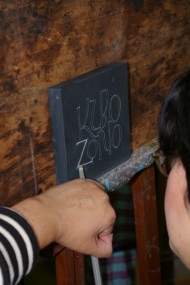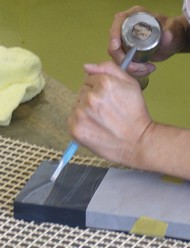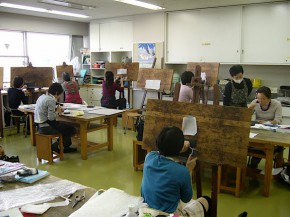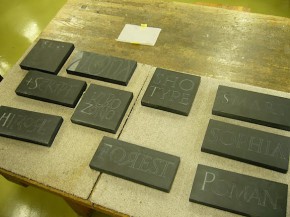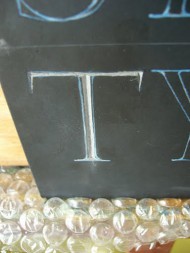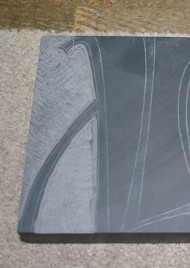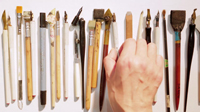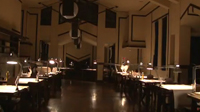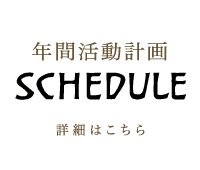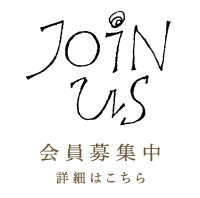A workshop titled “Introduction to Letter Cutting” was held in Osaka from 10/31/09 to 11/2/09 with a visiting instructor, Ms. Emi Gordon. Matching up to the philosophy of J-LAF, the workshop welcomed eleven attendees that included not only calligraphers but also graphic & letter designers and served as a new meeting place for calligraphy and printed letters.
Emi Gordon’s instruction formula was not limited to techniques. She also gave freedom for the attendees to think on their own and plenty of time to guide them to a solution. The result was a high-quality, accurate learning session. In addition to her engaging personality, her profound remarks– that had been cultivated through years of experience as a calligrapher in England – charmed and fascinated all those who attended the workshop.
The quality of a finished work – the beauty of a cut stone – is determined by the preparation process of letter cutting that takes place beforehand: That is to ask oneself, “How to perfect the letterforms and their arrangement” It is quite a contrast to the world of Gestural Writing (a form of calligraphy in which artistic emotions are expressed through the movement of lines) where the internally generated beauty of lines is sought after.
The process imposed the attendees a task, before actually cutting into the surface of a stone, of designing letters to be carved. The need for designers and calligraphers to come to a mutual agreement from their varied viewpoints became pleasant stimuli for the two parties who both deal with letters. It was a valuable encounter that allowed us to rediscover the possibilities of hand-written letters.
At the base of the beauty of letters that are carved into stone is the unshakable strength of those letters that will exist through many years without ever changing their intrinsic characters. In order to aim such a goal, one must first need to sit face to face with the letters rather than worry about the technique of carving a stone. It is no exaggeration to say that “to look closely at letterforms” is all that is required for attaining the goal. The ascertaining of the shapes and the placements of beautiful letters is done not by tools but by one’s eyes. Also, the knowledge of history and designs, the sense of beauty as well as the recognition of words’ connotation are all necessary factors.
Furthermore, letter cutting cannot be done simply with the perfection of letterforms. It is also a major prerequisite to be well acquainted with the physical material that makes up a stone. At this workshop, we were fortunate to experience the stone polishing process in the same method done in The Cardozo Kindersley Studio. Firstly, a stone is polished with sandpaper until the surface scratches become invisible. The polishing then continues earnestly under running water until the incongruity between one’s hands and the stone disappears. This process is vital in order for the hands and the stone to become as one and for establishing the feeling of awe toward the stone itself. I came to strongly believe that it was impossible to come face to face with the stone without going through this process. Also, in order to make the chisels “our own” tools, we learned to create them by sharpening them ourselves. Two days were spent to prepare our own tools, our own stone and our perfect letters. Without this intense preparation period, which was indispensable & valuable, this workshop would not exist.
When considering the length of time the letters we were about to carve might exist – which may be thousands of years – the two days we spent for preparation was but a fraction of a moment.
Coming face to face with the stone with which we had spent the treasured many hours in preparing it, the time has finally come to carve the stone. What a refreshing tension when we made the first cut! Our hearts bounced with the excitement of stepping into an unknown world. Our room became filled with the overlapping pleasant sounds of everyone’s dummies hitting the chisels. Time passed serenely as though we were in a stone carver’s atelier.いた。
The Cardozo Kindersley Workshop in England is a precious atelier that honors the tradition of mainstream arts & crafts movements. To learn that there is a Japanese woman in the atelier who has mastered the whole process of letter cutting from A to Z and who has gained the status of teaching the techniques to others was a profoundly meaningful and highly valuable discovery. Through this workshop, she has taught us solid techniques based on tradition, the fundamental attitude of never disrespecting the letters, as well as the deep spiritually that dwells not only within arts & crafts but also at the bottom of creation of all things.
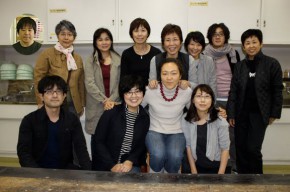

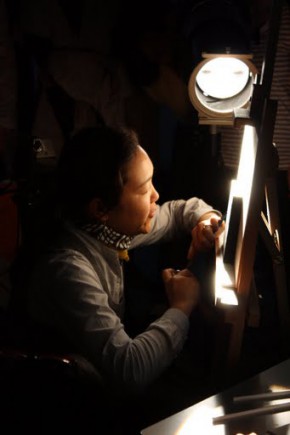 From Left: * Surrounding the instructor. * Emi Gordon cuts letters at the slideshow/demonstration venue in Tokyo, which followed the workshop in Osaka. In order to make it easier for the viewers to see her techniques, her area was lit by a spotlight. Also, a camera captured the close-up view of her hands and the image was sent to a screen by a projector.
From Left: * Surrounding the instructor. * Emi Gordon cuts letters at the slideshow/demonstration venue in Tokyo, which followed the workshop in Osaka. In order to make it easier for the viewers to see her techniques, her area was lit by a spotlight. Also, a camera captured the close-up view of her hands and the image was sent to a screen by a projector.
Emi Gordon
Emi Gordon began her calligraphy training in 1995 in Tokyo. After attending Thomas Ingmire’s workshop the following year, she decided to learn calligraphy overseas. Upon completing her preparation period of 2 years, she moved to England in 1997, then entered into Roehampton University’s calligraphy degree course. After graduating from the course in 2001, she became a pupil at a letter-cutting studio in Cambridge called The Cardozo Kindersley Workshop and worked for 4 ½ years until retiring from the studio to give birth to her first daughter in 2006. Presently, she continues to work independently in letter cutting and calligraphy. She received the CLAS’ Brian Walker Award in 2002 and attended SSI’s Advanced Training Scheme Course from 2002 through 2004.
http://www.tsukusidesign.com
Text: Minako Sando
Translation: Kako Ficara
Photos: Courtesy of Kunihiko Okano
